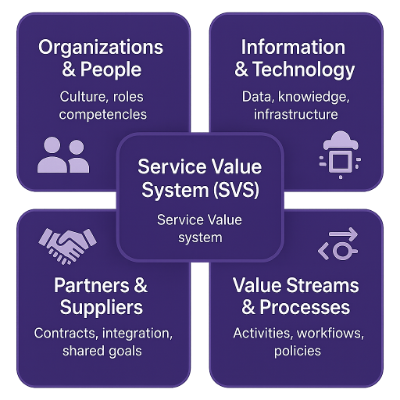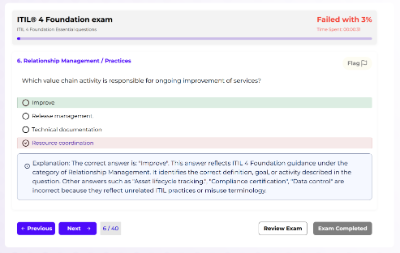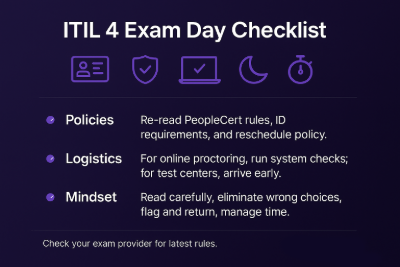ITIL 4 Foundation Overview and Who It’s For

ITIL 4 Foundation validates your understanding of modern IT service management. It’s ideal for career beginners proving IT knowledge, students seeking their first role, and mid-level managers formalizing ITSM skills. Build a simple plan, learn the core concepts, and practice in exam-like conditions to reduce surprises on test day.
Why Earn ITIL 4 Foundation?
ITIL 4 provides a shared language and toolkit for improving IT services. The certificate signals that you understand how services create value and how teams collaborate to deliver and improve them.
- RecognitionRespected entry credential across IT and operations.
- Career Start & MobilityHelps students and career-changers land support, analyst, or coordinator roles.
- Team AlignmentGives managers a common framework to improve reliability and customer experience.
ITIL 4 Foundation Exam Structure and Syllabus
Know the format and topics before you start. Practice in an interface that mirrors the real exam to lower test-day friction.
- Questions40 multiple-choice items, one correct answer.
- Time60 minutes (75 minutes if exam language is not your native/working language).
- Passing Score65% (26/40), closed-book.
- ProviderPeopleCert (online-proctored or test center).

What You Need to Know
Focus on ITIL 4’s big ideas and definitions. Foundation emphasizes understanding, not deep process design.
- Guiding PrinciplesSeven principles (e.g., Focus on value; Start where you are; Optimize and automate) that shape decisions and behavior.
- Four DimensionsOrganizations & People; Information & Technology; Partners & Suppliers; Value Streams & Processes.
- Service Value System (SVS)How Governance, Guiding Principles, Service Value Chain, Practices, and Continual Improvement work together.
- Service Value Chain (SVC)Plan, Improve, Engage, Design & Transition, Obtain/Build, Deliver & Support.
- Key PracticesKnow the purpose of core practices: Incident, Problem, Change Enablement, Service Request, Service Desk, Service Level, Continual Improvement, Relationship Management, etc.
Step-by-Step ITIL 4 Foundation Study Plan
Success starts with a simple, repeatable loop: learn → practice → review → improve. If you like structure, follow the steps below and keep weekly goals realistic.
- 1Skim the syllabus and glossary; list unknown terms.
- 2Study Guiding Principles and Four Dimensions first.
- 3Add SVS and SVC; connect concepts with quick notes.
- 4Review key practices and their purpose.
- 5Use a realistic 40-question simulator under time.
- 6Check analytics; target weak topics and pacing.
- 7Repeat short quizzes on weak areas, then full mocks.
- 8When scores stabilize, book your PeopleCert exam.
Step 1 — Skim the syllabus and glossary
Start by scanning the official syllabus and the ITIL glossary. List terms you don’t fully own yet (utility vs. warranty, output vs. outcome, value co-creation). This sets a precise vocabulary base so you avoid losing points to wording traps. Keep this list visible and tick items off as they become easy.
Step 2 — Study Guiding Principles and Four Dimensions first
Master the seven Guiding Principles and the Four Dimensions early—they show up everywhere. For each principle, write one real example from your work or study. For the Four Dimensions, map 1–2 examples each (e.g., a supplier SLA under ‘Partners & Suppliers’). If you can explain them simply, you’re ready.
Step 3 — Add SVS and SVC; connect the concepts
Connect how the Service Value System (SVS) components work together, then learn the Service Value Chain (Plan, Improve, Engage, Design & Transition, Obtain/Build, Deliver & Support). Draw a quick diagram linking a user request through Engage → Deliver & Support → Improve. This makes scenario questions intuitive.
Step 4 — Review key practices and their purpose
Focus on the purpose statements and when a practice is used, not deep process design. Know at least Incident, Problem, Change Enablement, Service Request, Service Desk, Service Level, Continual Improvement, Relationship Management. Be able to match simple scenarios to the correct practice quickly.
Step 5 — Use a realistic Exam Simulator That Feels Like the Real Test

Practice with timed 40-question sets and full mocks. Flag items, review explanations, and watch time per question. Randomization prevents rote memorization and builds real readiness.
- Real timing60-minute timer with visible countdown.
- Question qualityClear phrasing, single-answer MCQs with plausible distractors.
- Navigator & flagsSkip, mark for review, and return quickly.
- Progress trackingSee score trends, topic breakdowns, and pacing.
Step 6 — Check analytics; target weak topics and pacing

Look at topic performance and time per question. If ‘Four Dimensions’ drifts above ~95 seconds per item, schedule a short refresher and a 10-question focused quiz. Use analytics to pick 1–2 improvement goals for the next session.
Step 7 — Repeat short quizzes on weak areas, then full mocks
Alternate micro-quizzes (8–15 items) with one full 40-question mock every few days. Micro-quizzes rebuild speed and accuracy; full mocks build stamina and exam rhythm. Aim for clear gains in both score and pacing.
Step 8 — When scores stabilize, book PeopleCert and rehearse
When recent mocks hold above the pass mark with consistent timing, book the exam. Rehearse exam-day flow: rules, ID, room setup (if online), and your pacing plan (first pass fast, then review flags). Keep the day before light—brief review, no cramming.
Sample 6-Week ITIL 4 Study Plan (Adjust as Needed)
Adapt this roadmap to your workload. Keep the balance between learning concepts and timed practice to build recall and pacing.
- Week 1Orientation: exam format, glossary, and key concepts (value, services, outcomes/outputs, utility/warranty).
- Week 2Guiding Principles—study each principle and apply to short scenarios; 2–3 short quizzes.
- Week 3Four Dimensions—map examples from real life; do one 40-question timed set.
- Week 4SVS & SVC—understand interactions; mini-mocks and targeted review.
- Week 5Key practices—purpose and basic activities (Incident, Problem, Change, Service Desk, SL, CI, etc.); one full mock.
- Week 6Analytics-driven review; 1–2 full mocks; finalize booking and exam-day checklist.
Common ITIL 4 Prep Mistakes (and How to Avoid Them)
Avoid these traps to save time and raise scores.
- 1Skipping definitions. Foundation tests precise ITIL wording—use the glossary.
- 2Memorizing without context. Tie concepts to small scenarios for recall.
- 3No timed practice. Pace matters—train with 40-question sets.
- 4Ignoring analytics. Target weak topics and slow items every week.
- 5Cramming at the end. Small, regular sessions beat last-minute marathons.
Prepare for Exam Day
Reduce surprises: know the rules, set up your space (for online), and rest well the night before.
- PoliciesRe-read PeopleCert rules, ID requirements, and reschedule policy.
- LogisticsFor online proctoring, run system checks; for test centers, arrive early.
- MindsetRead carefully, eliminate wrong choices, flag and return, manage time.

Conclusion: Keep Your Plan Simple and Practice Like the Real Exam
Follow a plan you can keep. Practice under time, review every result, and let analytics guide your next week. When your timed mocks are consistently above the passing threshold with steady pacing, you’re ready to schedule with PeopleCert.
- Practice in real conditionsUse a clear interface with timer, navigator, and flags.
- Cover the syllabusPrinciples, Four Dimensions, SVS/SVC, and key practices.
- Learn from resultsClose gaps shown by topic performance and time per question.
